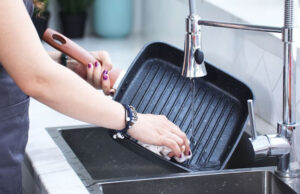There is a standard of cleanliness that we expect when we go out for a snack, a drink, or a meal. We demand that our food be well-made and free of harmful microorganisms, mold, flies, and hair. Restaurants are aware of and value the expectation from customers that their food will be both hygienic and safe.
You might have to wear a mask if you are a Kitchen worker. Our most popular, essential businesses—restaurants and grocery stores—will benefit from wearing masks because they will help stop the spread of disease. Move on And Read More about this issue.
Table of Contents
Are Masks Required For Kitchen Workers?
The new OSHA guidelines, which have been distributed to many states and municipalities through their health departments, have made working in kitchens even hotter and less comfortable. All workplaces, including kitchens, are encouraged to use PPE, according to these guidelines. Recent OSHA advice includes the following passages:
“Choose and implement the proper engineering controls (e.g., physical barriers/shields to separate workers, enhanced ventilation), and administrative controls (e.g., staggering work shifts, limiting breakroom capacity, practicing social distancing, replacing in-person meetings with video-conference calls, ensuring workers wear appropriate face coverings, such as cloth face masks, to contain respiratory secretions), and providing and ensuring workers use appropriate PPE chosen in accordance with hazard assessments, OSHA standards at 29 CFR 1910, Subpart I, and CDC and OSHA recommendations for using PPE (Notably, cloth face coverings are not PPE because they shield others from the wearer’s respiratory secretions rather than the wearer themselves.”
Even though you are separated from guests in a traditional closed kitchen setting and COVID-19 is not known to be transmitted through food, wearing masks or other face coverings can help to keep you and your coworkers safe. This is crucial as companies start to reopen in earnest and then some of them close down once more as the virus spreads among employees.
As I’ve gotten older, I’ve seen new health and safety regulations take hold, and cooks argue that they can’t do their jobs in those circumstances because they have to wear gloves to handle hot pizzas, keep their knives in sanitizing solution when not in use, keep dish towels off of their shoulders, and so on. Masks are indeed bothersome and uncomfortable. Yes, they have become the new normal for the time being. Chef-owner of Terrain in Glen Mills, Pennsylvania, Brian Lofink, says: “When I think about my coworkers’ and visitors’ health and safety, it takes a shift or two to get used to, but it’s worth the small sacrifice. For those who wear glasses, I’d also advise getting some anti-fog cream.”
Depending on your state or municipality as well as the company policy, a face covering may be advised or required, but it may not necessarily need to be a mask. Operators should speak with their regional restaurant association or health department. As an example, some chefs favor face shields because they can be just as effective as masks while still allowing for on-the-spot sampling.
CDC: Mask Guidelines
An excellent guide for using masks properly is provided by the CDC. To protect both yourself and your clients, if you’re required to wear a mask at work, you should follow these rules.
Most masks aren’t built to filter out every germ and bacterium in the air. Instead, they prevent sick people from spreading their germs and can occasionally block large incoming particles. They are especially crucial in preventing those who are ill but aren’t yet exhibiting symptoms from spreading their illness to others. If everyone wore masks, they could avoid infecting others with any illnesses they might have, and everyone would be safe.
Even when wearing a mask, the CDC advises keeping a six-foot space between you and other people to ensure everyone’s safety. Additionally, you should stay home from work and avoid going out in public if you are sick.
Various Types Of Masks
To prevent the spread of pathogens, the FDA provides information on a variety of face coverings that people use. Cloth masks are the most common and are advised by the CDC. In general, cloth masks do not shield the user from airborne bacteria. Instead, they stop sick or potentially sick people from spreading germs to others.
Cloth masks can be viewed as a partition separating a sick person from those around them. Even if you aren’t ill, you should cover your face when handling food when it’s necessary. Always wash it after each use!
Surgical masks may be chosen by some people. When supplies may be scarce for healthcare workers, the CDC advises against doing this. Surgical masks are made to prevent the spread of contagions and to stop the entry of large particles. Compared to cloth masks, they offer a little bit more coverage, but they are typically still loose-fitting. It is not recommended to reuse this kind of mask. Surgical masks should only be worn when absolutely necessary.
The best protection comes from N95 respirators. However, the CDC advises that only medical professionals should wear these. In order to shield the face from large particles and stop the spread of germs from one infected person to another, N95 respirators seal the face.
Similar to surgical masks, N95 respirators are not meant to be reused. However, the CDC advises only reusing N95 respirators a finite number of times if you don’t have access to enough of them to replace them whenever you need one. Consult your manager if you have any questions about your N95 reuse policy.
The CDC also offers advice on face shields, which are a secondary barrier between employees and customers in some establishments. These aren’t intended to serve as your main line of defense against illness. Instead, if you prefer to protect your face whenever you’re in close proximity to clients or coworkers, wear a face shield in addition to your mask. Face shields add an extra layer of defense against larger germ particles. Additionally, they ought to be washed after each use.
Researchers at Duke University conducted a study to assess the efficacy of various face coverings. They studied eight different kinds of masks in addition to the four we covered here, including bandanas and neck gaiters. They discovered that the best mask types for general use are cloth masks and surgical masks.
Use our poster about different types of masks in your business to remind customers of the differences between each type of face covering. To download and print the poster, select a size from the list below.
- 8.5 in x 11 in
- 18 in x 24 in
How To Put On A Mask Correctly To Stop The Spread Of Disease?
Masks must be worn properly in order to stop the spread of germs, according to the CDC. To make sure your mask is shielding you and those around you, follow these five steps:
- Before putting on your mask, give your hands a minimum of 20 seconds of soap and water washing. As much as possible, avoid touching the mask’s front. If you unintentionally touch the mask or after removing it, wash your hands.
- Choose a mask that makes it easy for you to breathe. You might need a new mask if you have breathing difficulties. Some people who have underlying medical issues might not be able to wear a mask. If this raises any concerns for you, speak with your manager.
- To ensure that the mask stays firmly in place on your face, wrap the mask’s straps around your ears. A slipping mask might not offer any protection.
- Verify that your mask is a tight fit for your face. You can double loop the straps over your ears and twist them to tighten it if it is too loose.
- Your mask should fit over your chin, completely enclose your mouth, and cover your nose. If it doesn’t, you probably need a bigger one.
Use this poster to serve as a reminder of how to put on a mask properly. To download and print the poster, click on one of the available sizes below.
- 8.5 in x 11 in
- 18 in x 24 in
The use of masks can help to stop the spread of disease. If you must wear one at work, make sure you understand how to do so to maximize its effectiveness.
Make sure you are aware of the FDA’s and the CDC’s most recent regulations if you are a food manager who needs to instruct your staff on masks.


